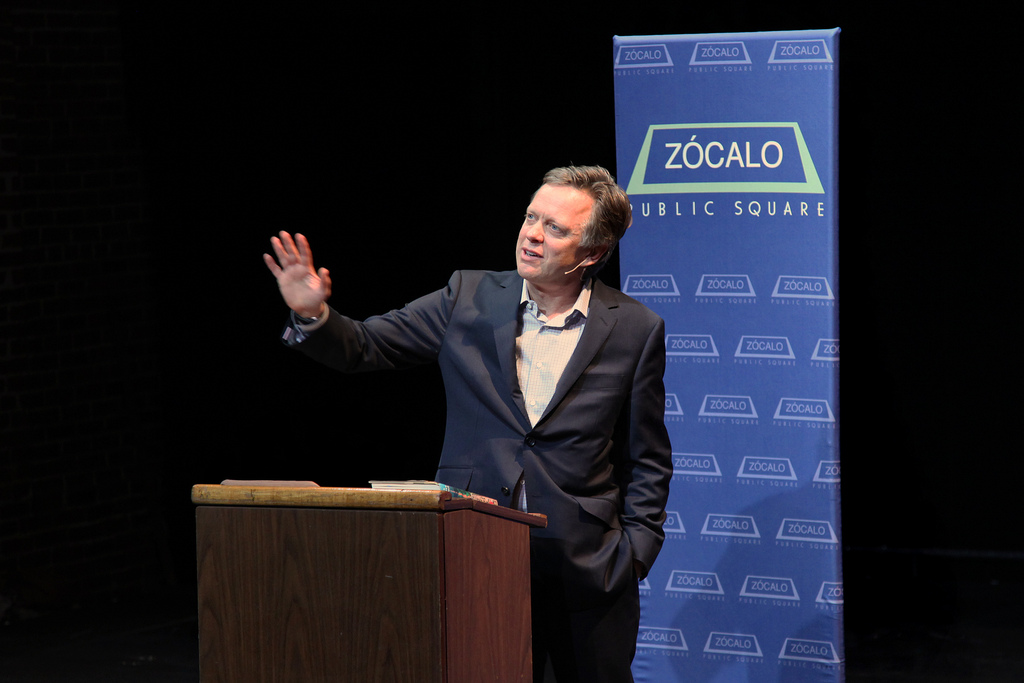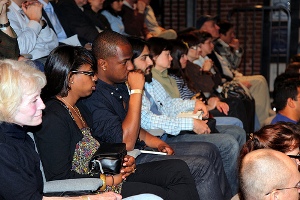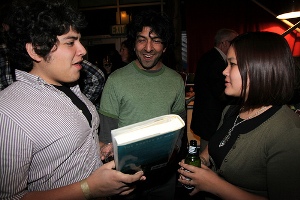
The six roads Ted Conover traveled for his The Routes of Man were not the first treacherous ones he came to know.
Working on his book Coyotes, Conover attempted a trip from Phoenix to Los Angeles with migrant workers in a beat-up station wagon. An hour along, the station wagon broke down, and the driver disappeared with the money Conover and his fellow travelers had paid for the trip. They finally hopped a Southwest flight for a quarter of what they’d paid their driver, got to Los Angeles, and took a taxi to an all-night donut shop in Santa Monica to wait for a relative of one of the men. But they found still more trouble when a drunk man punched Conover in the temple “for sitting with Mexicans,” Conover said.
The experience didn’t keep Conover off the road.
“Traveling on roads struck me as a good way to get to know just about anybody,” Conover said to the full house at The Actors’ Gang in Culver City, detailing his trips around the world and what he learned. “There is always something unexpected. You get to see how people handle it.”
Un-American
 Still, Conover began his first story about a road reluctantly. Charged to write for National Geographic about a road connecting the coasts of South America, he remembered thinking, “I had never aspired to write about infrastructure.” But he found that road, and all those he traveled, told more interesting tales: of towns suddenly shifting from remote to well-trod; the hidden places where roads dwindle into forests; booming development and impoverished natural environment; the spread of disease along truck routes; the necessity and vulnerability of roads in war. Although his book starts in New York – retracing the trail of imported mahogany to a Peruvian forest camp where everyone cuts wood to make a living – Conover kept away from American roads. “Where roads are new, you see their power more clearly,” he said.
Still, Conover began his first story about a road reluctantly. Charged to write for National Geographic about a road connecting the coasts of South America, he remembered thinking, “I had never aspired to write about infrastructure.” But he found that road, and all those he traveled, told more interesting tales: of towns suddenly shifting from remote to well-trod; the hidden places where roads dwindle into forests; booming development and impoverished natural environment; the spread of disease along truck routes; the necessity and vulnerability of roads in war. Although his book starts in New York – retracing the trail of imported mahogany to a Peruvian forest camp where everyone cuts wood to make a living – Conover kept away from American roads. “Where roads are new, you see their power more clearly,” he said.
Teens of the world
Even as he kept away from American roads, he found that global roads shared a key aspect with their U.S. counterparts: an inescapable allure for teenagers. Journeying to the isolated valley of Ladakh, in “the back of beyond,” Conover met Tibetan Buddhist teenagers who “like teenagers all over the world in small towns…want to go someplace bigger.” One adolescent boy had the same poster of Avril Lavigne as his daughter. “They want connections to the outside world,” Conover said.
In Ladakh, the only opportunity for that connection was a six-week window when a river through a gorge froze, with ice thick enough to walk on. The journey took three to four days, and the teens walked quickly to keep warm and spent nights in caves. Conover joined them on the trail and saw a road under construction, being built by the Indian army to supply troops amassed at the border with Pakistan. When Conover told the Ladakh travelers that the road would destroy their valley, “They could not believe anyone would have anything bad to say about the road.” Conover found the same reaction in the Amazon: “There is a passionate desire for roads in these remote places – people see them as a way to get the things we already have.”
Disease, bombs, gangs and charms
 Environmental dangers – and broke- down cars – weren’t the only risks Conover encountered. In Kenya, Conover traveled for six weeks with truckers, only half of whom are still alive. Without autopsies, causes of death aren’t clear, but many probably succumbed to AIDS, Conover said. Though many in the country deny AIDS and its impact, “Massive death has a way of transforming denial, and that’s what’s going on now.” (Conover noted that his primary guide, at least, seemed immune to the virus, remaining healthy despite having “more sex than anybody I have ever run into.”)
Environmental dangers – and broke- down cars – weren’t the only risks Conover encountered. In Kenya, Conover traveled for six weeks with truckers, only half of whom are still alive. Without autopsies, causes of death aren’t clear, but many probably succumbed to AIDS, Conover said. Though many in the country deny AIDS and its impact, “Massive death has a way of transforming denial, and that’s what’s going on now.” (Conover noted that his primary guide, at least, seemed immune to the virus, remaining healthy despite having “more sex than anybody I have ever run into.”)
In Afghanistan and Iraq, where Conover said his wife wouldn’t let him travel, roads are “the Achilles heel of an occupying army.” A road from Kabul to Kandahar cost $200 million to rebuild but when it was dedicated, everyone opted to fly in. “It was too dangerous to drive,” Conover said. He did make it to the West Bank, spending time both with Israeli paratroopers running checkpoints and Palestinians trying to travel through them. “Because I’m human I tend to make friends with the people I’m with, and I like them. It keeps happening to me,” he said. “You feel like you’re in a terrible, terrible place if you like people on both sides.”
In Lagos, Nigeria, Conover found ambulance crews parked at highway intersections because traffic moved so slowly that it made sense to wait for accidents where they might happen. Gangs shook down truck drivers and stole cargo as traffic idled. “Sometimes drivers punch or stab them, and then they come over to the ambulance, and the nurses sew them up,” Conover said. Rival police forces fight over turf. And drivers feel superstitious about roads and accidents, keeping good luck charms. One man Conover met credited surviving a fatal accident with such a charm, which itself did not survive the accident because it “had broken in the effort to save him and had no power left.” Conover, who kept his own totem, a gift from his wife, figured it was good luck “and would be until it wasn’t anymore.”
Need for speed
 In China, Conover took his most diverting road trips, dangerous in the old-fashioned American way of being too fast. He traveled with the Beijing Target Auto Club, men who simply “want to go really really fast.” His translator – a self described “taxi girl” who didn’t know “why men want to drive in cars so far” – accompanied him for weeks in central China. His driver’s car, a Hyundai Tucson, had accumulated 10,000 miles in three months. It had an auto club sticker with a number on the door, and a CB radio to connect him to other drivers. “He could not drive enough,” Conover explained. “I think in China this comes from a long feeling of being denied cars. The Soviet Union had more. The Chinese saw them on TV and in movies and knew the rest of the world was having all this fun.”
In China, Conover took his most diverting road trips, dangerous in the old-fashioned American way of being too fast. He traveled with the Beijing Target Auto Club, men who simply “want to go really really fast.” His translator – a self described “taxi girl” who didn’t know “why men want to drive in cars so far” – accompanied him for weeks in central China. His driver’s car, a Hyundai Tucson, had accumulated 10,000 miles in three months. It had an auto club sticker with a number on the door, and a CB radio to connect him to other drivers. “He could not drive enough,” Conover explained. “I think in China this comes from a long feeling of being denied cars. The Soviet Union had more. The Chinese saw them on TV and in movies and knew the rest of the world was having all this fun.”
The auto club men were speedy drivers. As Conover told his translator repeatedly to ask the driver to slow down, and explained that China is the most dangerous place on Earth to drive because of the fatality rate, the driver wouldn’t have it. “He looked over at me,” Conover said, “and sped up.”
Watch the video here.
See more photos here.
Buy the book here.
*Photos by Aaron Salcido.




Send A Letter To the Editors